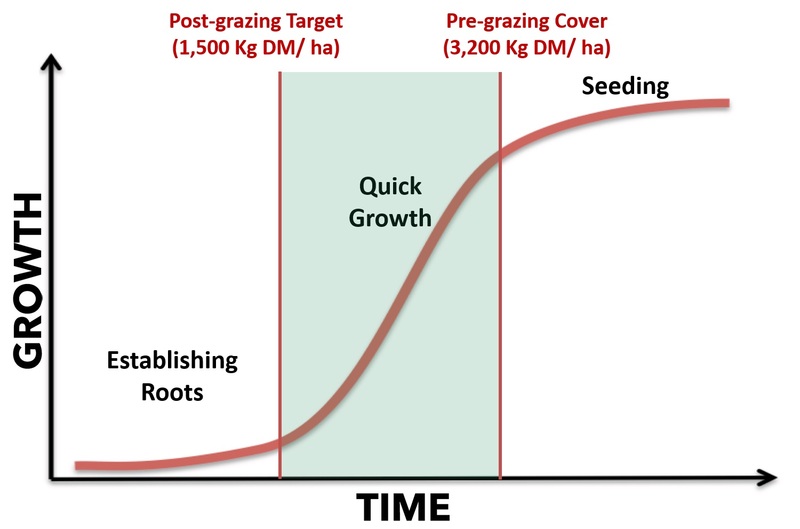Article Summary: Who said watching grass grow was boring? Understanding the growth of pastures, governed by the sigmoid growth curve, is fundamental for farmers and land managers. Recognising this curve's significance empowers farmers to decide when to graze, rest pastures, and manage irrigation and fertilisation. Additionally, factors like soil moisture and weather patterns play pivotal roles in grass growth. Sustainable pasture management practices, aligned with the sigmoid curve and these influential factors, foster healthier pastures. Read on to understand more about this fascinating topic!
Who said watching grass grow was boring? Not us here at pasture.io!
Grass, the foundation of a healthy pasture, has a fascinating growth pattern that plays a vital role in sustaining livestock and wildlife. Understanding how grasses grow, particularly their sigmoid growth pattern, is essential for farmers and land managers. Let’s delve into the nitty-gritty of grass growth, the sigmoid curve, and the influential factors that shape your pastures.
What is the sigmoid growth curve?
The sigmoid growth curve, often called an "S-curve", is a fundamental concept in understanding grass growth. This curve signifies the stages that grasses go through as they grow.
Picture a new sprout pushing through the soil, reaching for the sun. It starts slowly, then accelerates, and finally levels off. This progression mirrors the sigmoid curve, with distinct phases.
A sigmoid growth curve shows a gradual growth in the first phase, a more rapid growth in the middle, and a gradual slowing and levelling off at the end. The graph of this transition is S-shaped, due to which it is called S-curve.

Phases of sigmoid growth curve
The sigmoid curve consists of the following phases:
-
Phase I- Lag Phase: At the beginning, the grass establishes its roots and gets ready to grow.
-
Phase II - Exponential Growth: This is the phase where the magic happens. Grass experiences rapid growth, with leaves and stems shooting up as it harnesses energy from the sun through photosynthesis.
-
Phase III - Stationary Phase: Once the grass reaches maturity, growth slows, and it maintains a consistent height. This phase is when it's most palatable and nutritious for grazing animals.
Understanding this sigmoid curve is crucial for farmers. It helps in planning the timing of grazing and harvesting to ensure the pasture remains healthy and sustainable.
How does the sigmoid curve relate to grass growth?
Grass growth follows a sigmoid growth pattern. In the early stages of growth, the grass plant establishes its root system and does not put much energy into growing leaves and stems. Once the root system is established, the grass plant can grow more rapidly.
This rapid growth continues until the plant reaches its maximum height and biomass. Once the plant has reached its maximum height and biomass, growth slows and eventually stops.
This pattern of grass growth is essential in planning and managing the day-to-day movement of animals as part of your grazing management strategy.
Why is this important for farmers to understand?
As a farmer, you must understand the sigmoid growth pattern of grass to manage your pastures more effectively.
For example, you can use this information to determine:
-
When to start grazing your pastures.
-
How long you would graze them for.
-
When to rest them.
By understanding the sigmoid growth pattern of grass, you can also make better decisions about irrigation and fertilisation.
Other factors influencing grass growth
Some other factors also influence grass growth. They include soil moisture and weather.
The role of soil moisture
Soil moisture is one of the most influential factors affecting grass growth. Plants need adequate soil moisture to grow and thrive. Studies show that pasture pants need around 0.2 to 0.3 inches of soil moisture daily for optimal growth. Soil moisture directly impacts the speed and extent of the exponential growth phase in the sigmoid curve.
When moisture levels are insufficient, grass growth stalls, and pastures become less productive. If the soil is too dry, grass growth will be affected. If the soil is too wet, grass growth may also be affected due to root rot and other diseases.
Weather patterns, including rainfall and irrigation, are vital in maintaining adequate soil moisture. Monitoring and managing soil moisture levels are essential for sustaining healthy pastures. Farmers often use technology, such as soil moisture sensors, to ensure the grass receives the water it needs to grow optimally.
The role of weather
Weather is another key player in the complex game of grass growth. Sunlight is the energy source for photosynthesis, which fuels the exponential growth phase. Adequate sunlight is vital for lush, green pastures.
Rainfall is equally critical. Rain replenishes soil moisture and kick-starts the growth process. However, the timing and amount of rainfall can impact grass growth significantly. Droughts can lead to stunted growth, while excessive rain can cause waterlogging, negatively affecting the pasture.
Temperature is another aspect of weather that influences grass growth. Different grass species thrive in various temperature ranges. Understanding the ideal temperature for your specific grass type is essential to promote healthy growth.
Sustainable pasture management
You can foster thriving pastures by working in harmony with the sigmoid curve and considering these influential factors. Healthy pastures provide optimal nutrition for livestock and support the ecosystem.
To harness the true potential of sigmoid growth potential, sustainable pasture management practices are vital. You must adopt the right grazing management approach to ensure healthy pasture and livestock.
Nurture pastures through sigmoid growth
The sigmoid growth pattern of grass offers insights into the life cycle of these essential plants. As farmers and land managers, you must grasp this concept for maintaining healthy pastures. Additionally, understanding the impact of soil moisture and weather on grass growth enables better management practices.
Want to learn more about growing healthy pastures and the ins and outs of the growth process? Follow our industry-leading ag blog and keep updated with all the latest farming news and pasture findings!
Until we meet again, Happy Farming!
- The Dedicated Team of Pasture.io, 2023-11-06